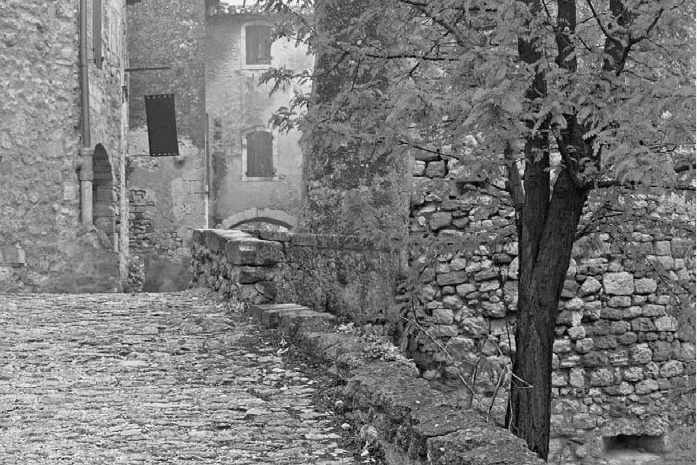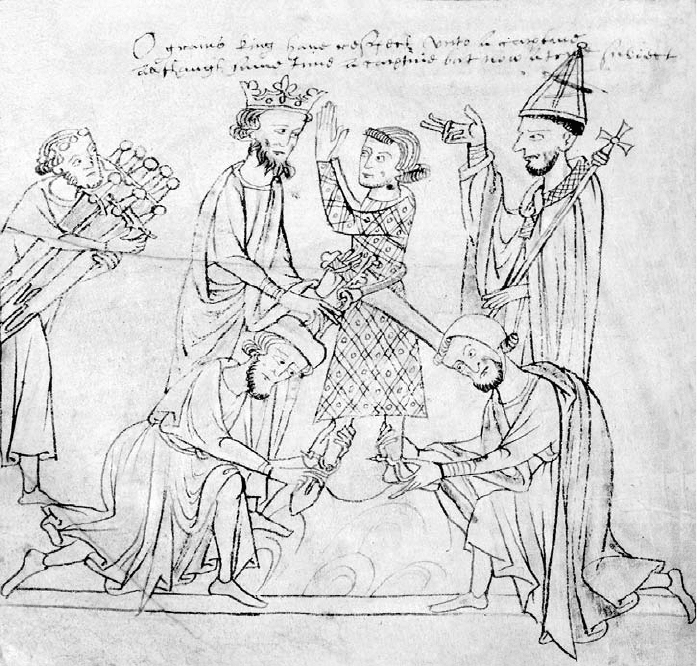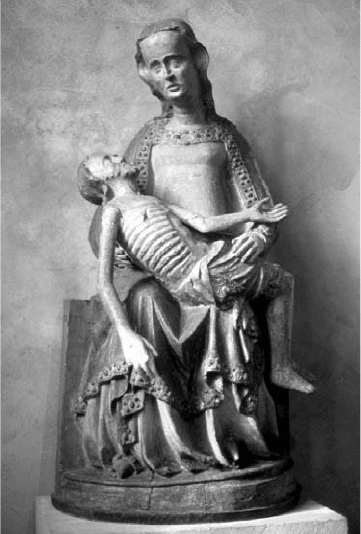Johnston R.A. All Things Medieval: An Encyclopedia of the Medieval World
Подождите немного. Документ загружается.

Roads
610
See also: Cathedrals, Church, Jewelry, Pilgrims, Saints.
Further Reading
Bagnoli, Martina, ed. Treasures of Heaven: Saints, Relics, and Devotion in Medieval
Europe . Baltimore: Walters Art Museum Press, 2010.
Cruz, Joan Carroll. Relics . Huntington, IN: Our Sunday Visitor, 1984.
Geary, Patrick J. Furta Sacra: Thefts of Relics in the Central Middle Ages . Trenton,
NJ: Princeton University Press, 1991.
Geary, Patrick J. Living with the Dead in the Middle Ages . Ithaca, NY: Cornell Uni-
versity Press, 1995.
Manseau, Peter. Rag and Bone: A Journey Among the World’s Holy Dead . New
York: Henry Holt, 2009.
Stalley, Roger. Early Medieval Architecture . Oxford: Oxford University Press,
1999.
Roads
In the early Middle Ages, well-designed stone Roman roads were still very
much in use. They were especially dense in Italy itself and in other regions
that had been well developed by the Romans. Italy’s road system was supe-
rior to that of Northern Europe all through the Middle Ages.
In Spain, France, and England, the Roman roads gradually fell into disre-
pair. Romans only built roads that linked their forts and towns, and Europe
outgrew this infrastructure once the period of barbarian attacks ended. The
last Roman-style roads were built in northern France around 600. Until
very late in the medieval period, road building was not a priority. New cit-
ies grew where there had never been stone roads.
Roads were rarely built by planning but were developed when they led
to a destination: castle, monastery, church, market, port, bridge, or cem-
etery. They were named according to where they went or what purpose
they served. A road used to transport shipments of salt might be called
Saltsway.
Medieval roads may be best considered as strips of land where private
landowners gave people the right of way to walk and ride. In England,
some statutes stipulated that travelers could travel next to a road without
being charged with trespassing, if (and only if) the road had fallen into se-
rious disrepair. Landowners had an incentive to keep the roads repaired if
they didn’t want horses and wagons to drive onto their land. Road re-
pair in the Middle Ages generally meant leveling out the ruts and putting
gravel into swamps or other depressions.
Some roads had been in use since prehistoric times. Some had served early
medieval (such as Anglo-Saxon or Frankish) armies. Some were royal roads

Roads
611
and were maintained to the king’s standards: in England, wide enough for
two wagons to pass. Wider roads developed along routes for driving cattle,
and alternate roads developed in places where travelers wished to avoid
tolls. Multiple roads developed on hills, so a traveler could choose which
path looked least steep.
Kings and other noblemen traveled frequently as they moved from
manor to manor. The English kings of the 13th and 14th centuries traveled
almost continually, and they carried baggage in up to 20 wagons. Although
the roads must have been diffi cult, they also must have been passable. We
see glimpses into the diffi culties of travel in kings’ records: shortly before
his death, King John’s wagons had an unlucky ford crossing, and his crown
and other jewels were lost.
The paving of town streets in Northern Europe came late in the Middle
Ages. Large towns such as Paris and London wanted to improve sanita-
tion and began to build cobbled streets with drains and gutters in the 12th
century. It was slow and expensive, as workmen sat in the street on three-
legged stools and pounded rocks or bricks into the dirt. The result was
easier to keep clean, and it shed rainwater into the drains.
By the late Middle Ages, cities had begun to pave roads with cobblestone or brick.
Stone paving required men on stools to fi t and pound stones into the dirt roadway,
kneeling on stools and working inch by inch. It was a slow, expensive undertaking, so
at fi rst they paved only the main streets in the biggest cities. Paved streets remained a
real mark of distinction until the modern age. (S. Greg Panosian/iStockphoto)
Roland, Song of
612
Italian towns tended to have more paved roads, perhaps because of their
Roman traditions. Rome’s streets had been paved since antiquity. In grow-
ing commercial towns like Bologna and Milan, many roads were paved with
brick or stone. Property owners were responsible for paving the street in
front of their buildings, and the city paved main streets and plazas.
See also: Bridges, Cities, Wagons and Carts.
Further Reading
Davies, Hugh. Roman Roads in Britain. Botley, UK: Shire Publications, 2009.
Harrison, David. The Bridges of Medieval England: Transport and Society,
400–1800. Oxford: Oxford University Press, 2008.
Hindle, Paul. Medieval Roads and Tracks. Princes Risborough, UK: Shire Publica-
tions, 1998.
Taylor, Christopher. Roads and Tracks of Britain. Worthing, UK: Littlehampton
Book Services, 1982.
Roland, Song of
The “Song of Roland” was the most popular epic of its time. Composed
by a Frankish minstrel named Turoldus, the poem fi rst appeared in writ-
ten form around 950. Its subject matter was Charlemagne’s invasion into
Muslim Spain in 778. The oral version may have been in circulation for
years before it was written, but it was probably not composed close to the
time of the events.
In the song, Roland is the Count of Brittany and Charlemagne’s nephew.
He is guarding the rear of a triumphant departure from Spain, after a mili-
tary campaign of seven years in which the Christian Franks conquered al-
most all of Muslim Spain. The narrow pass over the Pyrenees mountains,
from Spain into France, forces the huge army to travel slowly, and the bag-
gage train at the back is miles behind. Roland’s stepfather Ganelon has
conspired with the Saracen ruler Marsile to attack Roland when he is iso-
lated. Roland compounds this disaster by ignoring his friend Oliver’s pleas
to blow an ivory horn called the “Oliphant,” which would summon help.
When he fi nally blows it, help cannot arrive in time, and they are all slaugh-
tered. While this is the most famous incident in the long epic, the story
goes on to tell of Charlemagne’s vengeance against Marsile, the burial of
Roland and his companions, and an enormous battle between Muslims and
Christians. The Frankish Christians win, and their Muslim enemies either
die or convert.
In the historical events, Roland was a nobleman of Brittany, but he may
not have been related to the king; little is known about him. He guarded
the baggage in the rear, and the main army went ahead over the narrow

Roland, Song of
613
pass of Roncesvalles. Charlemagne’s campaign had not been long or vic-
torious; his army had entered at the invitation of some rebellious Muslim
rulers in northern Spain who wanted to rebel against the growing power
of Abd al-Rahman of Cordoba, who had come to rule about two-thirds of
Spain. The rebellion failed, and support melted away. A frustrated Char-
lemagne heard that the Saxons of Germany were rebelling against Frank-
ish rule and headed back to the Pyrenees to cross into France. The city of
Pamplona, home of Christian Basques, closed its gates to him, and his army
destroyed it. As the army passed over the Pyrenees, vengeful Basques, and
The “Song of Roland” was the best-seller of its time as both a song and a storybook.
This copy was lavishly illustrated, by 11th-century standards. This picture may
show the knighting of young Roland. A bishop stands by to bless him as the king
gives him a sword. Servants, possibly other knights, attach his spurs. Roland’s minor
defeat was turned into an epic of victory over the Saracens, medieval Europe’s
chronic foes. (The British Library/StockphotoPro)
Roland, Song of
614
probably some Muslims, attacked Roland and stole the plunder and other
baggage the Franks were carrying out of Spain.
See also: Minstrels and Troubadours, Muslims.
Further Reading
Lewis, David Levering. God’s Crucible: Islam and the Making of Europe, 570–1215 .
New York: Norton, 2008.
Merwin, W. S. The Song of Roland . New York: Modern Library, 2001.
S S
Saints
617
Saints
Medieval Christians believed that among the perfect souls who went straight
to heaven, some had been so good on earth that they had higher standing
in heaven. These included monks who had done notable charitable works
and many martyrs who had been killed for their faith. These holy ones,
sancti in Latin and saints in English, could look down on earth and see
what people were doing. They could hear prayers and work miracles.
Dead people were certifi ed as saints if they had lived saintly lives, or if
they did not smell rotten after their death (this was called “the odor of
sanctity”), and if they appeared to work miracles after death. A miracle
meant that God had listened to the saint when he or she spoke on behalf
of a humble petitioner, and it certifi ed the saint’s position of infl uence in
heaven. Medieval people had a low-threshold of defi nition for a miracle. It
could be any improvement within a reasonable time frame, including natu-
ral recovery. It did not have to be immediate, and it was still a miracle if the
person later became sick again.
During the 10th century, the church began to control the process of
certifying dead people as saints. During the early years of Christianity, the
test had been simple: a martyr’s death. After there were fewer martyrs,
saintly lives or evidence of miracles at a tomb made people saints. By 1215,
the Fourth Lateran Council proclaimed that only the Pope could deter-
mine who was a saint. The process was called canonization, and the Papal
Court needed evidence of a saintly life and detailed evidence of specifi c
miracles. The petitioner who submitted the saint’s name for consideration
had to pay the costs of the investigation, so fewer saints were named in the
later Middle Ages.
Many medieval people still venerated local, unoffi cial saints. As the can-
onizing process became more formal, some of these locally selected saints
were called blessed, beati, rather than saints, sancti . The local people felt
strongly about them, but they could not afford the sainthood process or
perhaps the saint would not have passed Rome’s stricter standards. One
local French saint would never have passed the Pope’s scrutiny. Saint Guine-
fort was a dog, killed by his master by mistake while protecting the master’s
baby son. The canine saint was venerated by the local people, who brought
sick babies to the dog’s grave.
Relics of saints were thought to have special power to work miracles in
the saint’s name. Most commonly these relics were slivers of bone, often
said to be the fi nger of a saint. One saint’s relic was his head, pickled in a jar.
Other relics could include scraps of cloth they had worn or blessed or items
they had used. Shards of a saint’s tombstone could also carry the blessing
of the saint. Many monasteries and churches built their fame around own-
ing relics. The Crusades gave wide opportunity for relics real and false (and

Saints
618
often stolen property) to be carried back to Western Europe. They were
housed in elaborate boxes called reliquaries.
The foremost saint was Jesus’s mother, Mary. During the 12th century,
devotion to her as the Mater Dei (Mother of God) grew all over Europe.
Many people believed Mary had been born without sin, and they revered
her as the perfect woman. Many churches and monasteries were dedicated
to Mary. Medieval art, both painting and sculpture, showed Mary with
her baby son and with her son crucifi ed. People prayed to Mary in the be-
lief that if Mary asked Jesus to grant their petitions, he could not turn down
his mother.
Other saints included the 12 disciples, Roman Christians who had died
for their faith, and missionaries like the Anglo-Saxon Boniface. The most
famous saint of the Middle Ages was Saint Thomas à Becket, the arch-
bishop of Canterbury who was murdered at the altar of his cathedral in
1270. His tomb became a central place of pilgrimage in England.
Many people were named for saints; after the archbishop’s murder, thou-
sands of English babies were named Thomas. The calendar had saints des-
ignated for every day of the year, often more than one. Sometimes people
were named for the saint on whose day they were born. Many regions had
local saints, and those names were more popular.
Devotion to Mary, the highest saint in
the hierarchy, increased during the
Middle Ages. Her image in heaven
was of a queen in a shining crown,
but her image on earth centered on
the sorrows she felt as a mother.
Tradition said that the body of Jesus
was taken from the cross and laid on
her lap. A pieta was a sculpture of this
scene. By the late Middle Ages and
into the Renaissance, it was one of the
most popular images of Mary. (Allan
T. Kohl/Art Images for College
Teaching)
Salt
619
People believed saints had particular concerns, based on what they had
done while they were on earth. These saints became the patron saints for
crafts or places or were called on for certain kinds of help. Sometimes, the
link was direct and easy to understand, such as Saint Dunstan as the saint
for English goldsmiths, since he had been a metal worker. Other times, the
link was more obscure. Saint Barbara’s father, who beheaded her, was killed
by lightning, so Saint Barbara was the saint who could help with danger-
ous thunder and lightning, but she was also the patron saint of miners, who
used explosives.
Many saints were designated as the helpers for various medical prob-
lems. Their link with these problems was sometimes connected to their
lives and deaths. Saint Clair, who had her eyes put out, was the saint who
helped with eye problems and blindness. Saint Agatha’s breast was cut off,
so she paid particular attention to prayers concerning breast cancer, breast
injuries, and breast-feeding. The links with saints and their concerns were
not even always known. For whatever reasons, Saint Sebastian helped with
plague, Saint Osyth with fi re, and Saint Oswald with sick animals. Saint
Margaret was the helper of all midwives and childbirths.
Some saints resided at places, although they were, of course, in heaven.
Mary’s tunic at Chartres, and other relics of Mary in other places, allowed
these places to claim Mary lived with them. Saint Denis had been buried
at the abbey named for him in Paris, and Saint Martin’s tomb in Tours
fi xed him there. Saint Anthony of Padua and Saint Francis of Assisi were
considered to have lived in their burial locations. When a saint was defi -
nitely buried at a place, his favor surely could best be gained by going there
to pray.
See also: Church, Medicine, Pilgrims, Relics.
Further Reading
Abou-El-Haj, Barbara F. The Medieval Cult of the Saints. Cambridge: Cambridge
University Press, 1997.
Bagnoli, Martina, ed. Treasures of Heaven: Saints, Relics, and Devotion in Medieval
Europe. Baltimore: Walters Art Museum Press, 2010.
Cruz, Joan Carroll. Relics. Huntington, IN: Our Sunday Visitor, 1984.
Salt
Salt occurs in almost every environment on earth, either as seawater or
water from a salt spring or as rock salt below the earth’s surface. Since an-
cient times, people have known that salt is necessary for human life and for
preserving food. Water that contains salt is called brine; as water evapo-
rates, the brine becomes saltier. As salinity continues to increase, salt crystals
